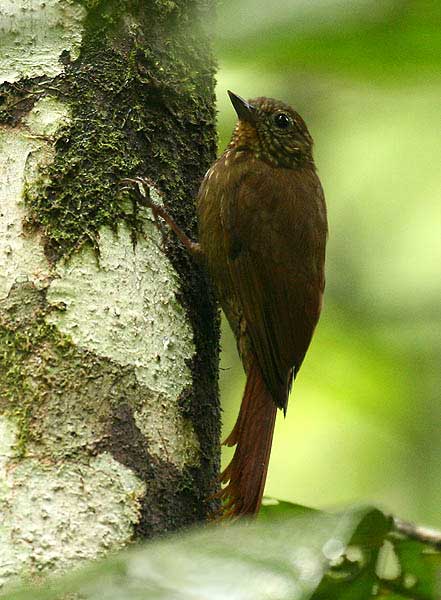
Glyphorynchus spirurus (*)
Superregnum: Eukaryota
Cladus: Unikonta
Cladus: Opisthokonta
Cladus: Holozoa
Regnum: Animalia
Subregnum: Eumetazoa
Cladus: Bilateria
Cladus: Nephrozoa
Superphylum: Deuterostomia
Phylum: Chordata
Subphylum: Vertebrata
Infraphylum: Gnathostomata
Megaclassis: Osteichthyes
Cladus: Sarcopterygii
Cladus: Rhipidistia
Cladus: Tetrapodomorpha
Cladus: Eotetrapodiformes
Cladus: Elpistostegalia
Superclassis: Tetrapoda
Cladus: Reptiliomorpha
Cladus: Amniota
Classis: Reptilia
Cladus: Eureptilia
Cladus: Romeriida
Subclassis: Diapsida
Cladus: Sauria
Infraclassis: Archosauromorpha
Cladus: Crurotarsi
Divisio: Archosauria
Cladus: Avemetatarsalia
Cladus: Ornithodira
Subtaxon: Dinosauromorpha
Cladus: Dinosauriformes
Cladus: Dracohors
Cladus: Dinosauria
Ordo: Saurischia
Cladus: Eusaurischia
Subordo: Theropoda
Cladus: Neotheropoda
Cladus: Averostra
Cladus: Tetanurae
Cladus: Avetheropoda
Cladus: Coelurosauria
Cladus: Tyrannoraptora
Cladus: Maniraptoromorpha
Cladus: Maniraptoriformes
Cladus: Maniraptora
Cladus: Pennaraptora
Cladus: Paraves
Cladus: Eumaniraptora
Cladus: Avialae
Infraclassis: Aves
Cladus: Euavialae
Cladus: Avebrevicauda
Cladus: Pygostylia
Cladus: Ornithothoraces
Cladus: Ornithuromorpha
Cladus: Carinatae
Parvclassis: Neornithes
Cohors: Neognathae
Cladus: Neoaves
Cladus: Telluraves
Cladus: Australaves
Ordo: Passeriformes
Subordo: Tyranni
Infraordo: Tyrannides
Parvordo: Furnariida
Superfamilia: Furnarioidea
Familia: Furnariidae
Subfamilia: Dendrocolaptinae
Genus: Glyphorynchus
Species: Glyphorynchus spirurus
Subspecies: G. s. albigularis – G. s. amacurensis – G. s. castelnaudii – G. s. coronobscurus – G. s. cuneatus – G. s. inornatus – G. s. integratus – G. s. pallidus – G. s. paraensis – G. s. pectoralis – G. s. rufigularis – G. s. spirurus – G. s. subrufescens
Dubious taxon or synonym: G. s. sublestus – included in pectoralis.
Name
Glyphorynchus spirurus (Vieillot, 1819)
Type locality: South America = "Cayenne"
Synonyms
Neops spirurus (protonym)
Glyphorhynchus spirurus (orth. err.)
References
Primary references
Vieillot, L.J.P. 1819. Nouveau Dictionnaire d’Histoire naturelle, appliquée aux arts, à l'agriculture, à l'économie rurale et domestique, à la médecine, etc. Par une société de naturalistes et d'agriculteurs. Avec des figures tirées des trois règnes de la nature. Tome 31. 577 pp. + 7 tt. Déterville, Paris. p. 338 BHL Reference page.
Additional references
Fernandes, A.M., González, J.B., Wink, M. & Aleixo, A. 2013. Multilocus phylogeography of the Wedge-billed Woodcreeper Glyphorynchus spirurus (Aves, Furnariidae) in lowland Amazonia: Widespread cryptic diversity and paraphyly reveal a complex diversification pattern. Molecular Phylogenetics and Evolution 66(1): 270–282 DOI: 10.1016/j.ympev.2012.09.033 Reference page.
Vernacular names
English: Wedge-billed Woodcreeper
español: Trepatroncos picocuña
português: Arapaçu-bico-de-cunha
The wedge-billed woodcreeper (Glyphorynchus spirurus), is a passerine bird which breeds in the tropical New World from southern Mexico to northern Bolivia, central Brazil and the Guianas; it is absent from the Pacific coastal areas except between Costa Rica and Ecuador. It is the only member of the genus Glyphorynchus.
It is easily distinguished from its relatives by its small size and distinctive bill. The wedge-billed woodcreeper is typically 14–15 cm long, and weighs 14–16.5 g. It has brown upperparts, with fine streaking on the head sides, a buff supercilium, and a chestnut rump, wings and tail. The throat is buff, and the rest of the underparts are brown spotted with buff chevrons, most heavily on the breast. A buff wing bar is obvious from below in flight. The short wedge-shaped bill is quite different in shape from that of other woodcreepers. Young birds are duller with less distinct breast streaking.
The call is a sneezy schip. The song varies geographically, perhaps reflecting the different subspecies of this bird. In Costa Rica it is a trilled keekekekiki, whilst in eastern Bolivia it is an ascending too-e too-e tu-tu-tu-tue-twu-twu-tweeet.
This common and widespread small woodcreeper is found in lowlands up to 1500 m altitude, although normally below 1100 m, in damp forests, adjacent semi-open woodland and old second growth. It feeds on small spiders and insects, creeping up trunks and extracting its tiny prey from the bark. It has a strong preference for trees with fine flaky bark. It is seen alone, in pairs, or sometimes as part of a mixed-species feeding flock. Birds are largely resident, but may disperse locally. For example, a vagrant individual was observed on May 12, 1998 at Cerro Campana, El Salvador, the first record for that country.[2]
It builds a cup nest in a narrow tree cavity such as a rotting stump or space between buttresses. It may occasionally nest up to 6 m high in a tree, but is usually much lower, often at or below ground level. It lays two white eggs between March and June.
Footnotes
BirdLife International (2020). "Glyphorynchus spirurus". IUCN Red List of Threatened Species. 2020: e.T22703043A140070412. doi:10.2305/IUCN.UK.2020-3.RLTS.T22703043A140070412.en. Retrieved 12 November 2021.
Herrera et al. (2006)
References
Herrera, Néstor; Rivera, Roberto; Ibarra Portillo, Ricardo & Rodríguez, Wilfredo (2006): Nuevos registros para la avifauna de El Salvador. ["New records for the avifauna of El Salvador"]. Boletín de la Sociedad Antioqueña de Ornitología 16(2): 1-19. [Spanish with English abstract] PDF fulltext
Hilty, Steven L. (2003): Birds of Venezuela. Christopher Helm, London. ISBN 0-7136-6418-5
Stiles, F. Gary & Skutch, Alexander Frank (1989): A guide to the birds of Costa Rica. Comistock, Ithaca. ISBN 0-8014-9600-4
Further reading
Skutch, Alexander F. (1969). "Wedge-billed woodcreeper" (PDF). Life Histories of Central American Birds III: Families Cotingidae, Pipridae, Formicariidae, Furnariidae, Dendrocolaptidae, and Picidae. Pacific Coast Avifauna, Number 35. Berkeley, California: Cooper Ornithological Society. pp. 392–395.
Retrieved from "http://en.wikipedia.org/"
All text is available under the terms of the GNU Free Documentation License

